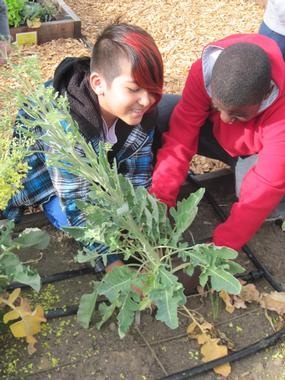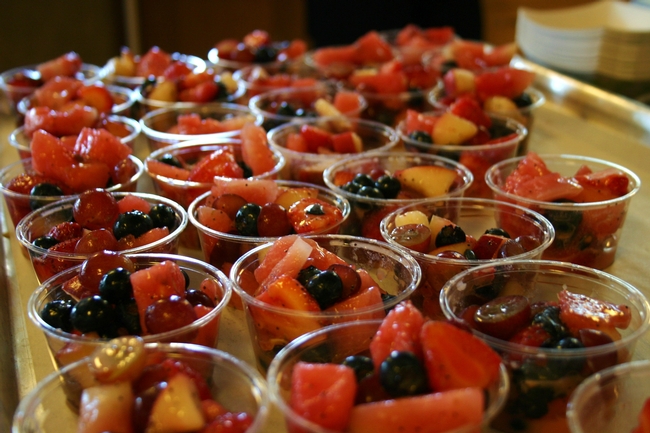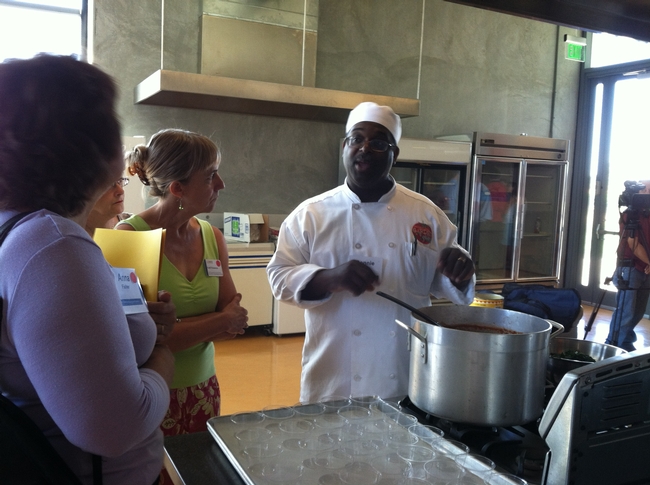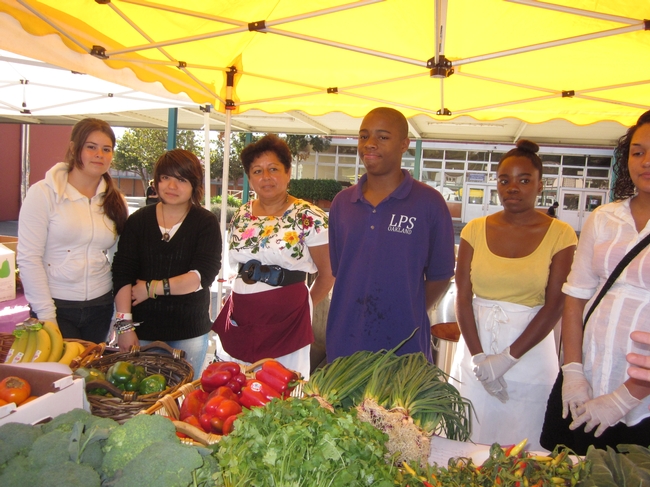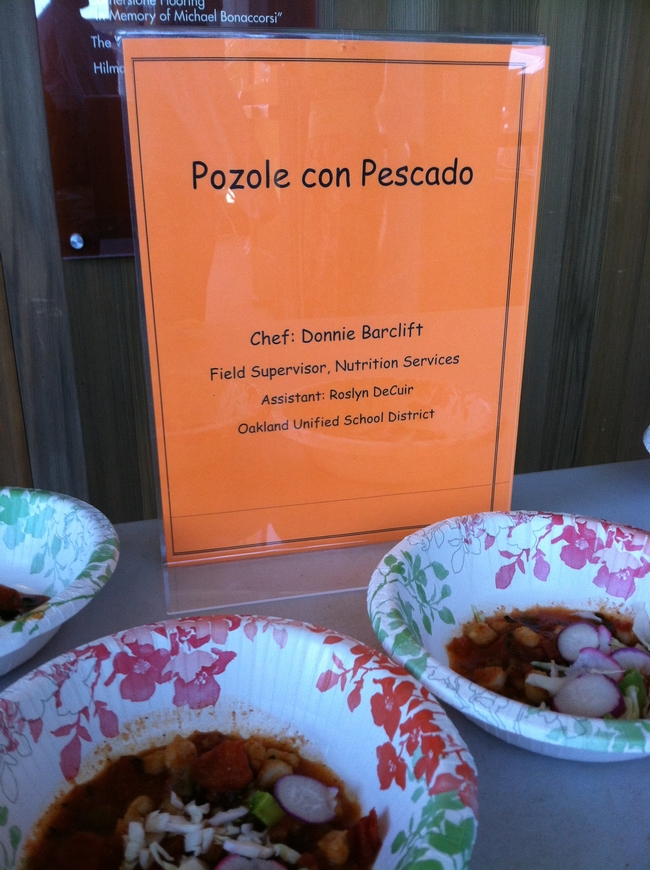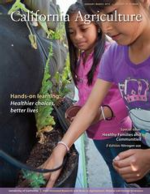Posts Tagged: Sheri Zidenberg-Cherr
Shaping Healthy Choices combines approaches to make a lasting impression on kids
You can lead a child to fresh fruits and vegetables, but how do you entice them to eat healthful foods when you aren't watching?
“Simply offering healthy options is not enough to motivate children to make healthy choices,” said Sheri Zidenberg-Cherr, UC Cooperative Extension specialist in the Department of Nutrition at UC Davis.
“Moreover, imposing restrictions rather than providing children with options to make healthy choices can have long-term negative effects,” said Rachel Scherr, assistant project scientist, also in the UC Davis Department of Nutrition.
In 2012, more than one-third of children in the U.S. were overweight or obese, according to the Centers for Disease Control and Prevention. Studies have shown that obese children are more likely to be obese as adults, increasing their risk for health problems including heart disease, type 2 diabetes, stroke, cancer and osteoarthritis. To target the complex issue of eating habits, Zidenberg-Cherr and her UC Cooperative Extension and UC Davis colleagues designed a school-based program and tested it in Sacramento and Stanislaus counties through the leadership of UCCE nutrition, family and consumer science advisors Terri Spezzano and Yvonne Nicholson.
“Parents shared with me that their children are voicing input on meals and asking if they can add fruit to their salads,” a participating teacher told the researchers.
During the first year that the Shaping Healthy Choices Program was implemented in Sacramento County schools, the number of children classified as overweight or obese dropped from 56 percent to 38 percent. The participating students also improved their nutrition knowledge, ability to identify different kinds of vegetables and amounts of vegetables that they reported eating.
“I tried zucchini and yellow squash when I was little and didn't like it, but now I tried it and I love it!” said a 9-year-old student.
The Shaping Healthy Choices Program takes a multifaceted approach, combining nutrition education with family and community partnerships, regional agriculture, foods available on school campus and school wellness policies.
The garden-enhanced, inquiry-based nutrition curriculum was developed by Jessica Linnell, a doctoral candidate in the Graduate Group in Nutritional Biology; Carol Hillhouse, the School Garden Program director at the Agricultural Sustainability Institute; and Martin Smith, a UCCE specialist in the Departments of Human Ecology and Population Health and Reproduction. The family and community partnerships featuring family newsletters were developed by Carolyn Sutter, a graduate student in the Graduate Group of Human Development, and Lenna Ontai, a UCCE specialist in the Department of Human Ecology. Lori Nguyen, a doctoral candidate in the Graduate Group in Nutritional Biology, Sheridan Miyamoto, postdoctoral scholar in the Betty Irene Moore School of Nursing, and Heather Young, dean of the Betty Irene Moore School of Nursing, organized community-sponsored health fairs.
Gail Feenstra, deputy director and food systems analyst for the UC Agricultural Sustainability Institute, helped the schools set up systems to add fresh, locally grown produce to their menus. Jacqueline Bergman, a postdoctoral scholar in the Department of Nutrition, coordinated school-site specific wellness committees.
The UC Cooperative Extension and UC Davis team worked with classrooms to use Discovering Healthy Choices, a standards-based curriculum that incorporates interactive classroom nutrition, garden and physical activity education for upper elementary school students. Teachers partnered with UCCE to incorporate cooking demonstrations to show the connections between agriculture, food preparation and nutrition. To reinforce the lessons at home, Team Up for Families – monthly newsletters containing nutrition tips for the parents – were sent home with the students. School Nutrition Services purchased fruits and vegetables from regional growers and distributors to set up salad bars and prepare dishes made with fresh produce. The Shaping Healthy Choices Program activities were integrated into the school wellness initiatives.
“My students shared things they learned about safe food handling and safety in cooking,” said a teacher who participated in the study. “Parents said their children want to help in preparing meals at home.”
“My daughter is more interested in trying new foods and eating more fruits and vegetables,” reported one parent. “She often surprises the family by making a surprise salad snack for everyone.”
Preliminary analysis shows that nine months after the classroom education ended, the decrease in the students' body mass index percentiles, or BMI percentiles, was sustained. “This is a big deal,” said Zidenberg-Cherr, while cautiously encouraged by the program's success. “We are in the process of analyzing several aspects of the program — the data set is so complex and I have to feel 100 percent confident in our statements.”
Through a partnership with UC CalFresh, the researchers have expanded the comprehensive program to schools in Placer, Butte and San Luis Obispo counties. Determining feasibility for expansion of the program for broader dissemination is planned for the 2015-2016 school year.
This project was funded by grants from the UC Division of Agriculture and Natural Resources and the U.S. Department of Agriculture.
The University of California Global Food Initiative aims to put the world on a path to sustainably and nutritiously feed itself. By building on existing efforts and creating new collaborations among UC's 10 campuses, affiliated national laboratories and the Division of Agriculture and Natural Resources, the initiative will develop and export solutions for food security, health and sustainability throughout California, the United States and the world.
Kids drop pounds, eat more veggies with nutrition program
The percentage of overweight or obese children in test schools dropped from 56 percent to 38 percent over the course of a single school year, thanks to a new nutrition program developed and tested in the classroom by nutrition researchers at the University of California, Davis.
The new program fits into the new Common Core educational standards.
"The education component of this program is intended to help children develop nutrition-related problem solving skills," said co-author Jessica Linnell, a senior doctoral candidate in the UC Davis Department of Nutrition. "We think that these skills, combined with knowledge about foods, may be critical in order for children to make healthy choices."
Researchers say the program could be adopted nationally at little cost to schools. The program was pilot-tested for this study in schools located in Sacramento and Stanislaus counties. Study findings were reported recently during the Experimental Biology 2014 meeting.
"When we designed the study, we anticipated short-term outcomes such as kids having more knowledge of nutrition or being able to identify more vegetables," said Rachel Scherr, assistant project scientist in the UC Davis Department of Nutrition and one of the study's lead investigators. "We always had a long-term goal of decreasing body mass index, but we didn't anticipate that it would happen in such a short timeframe, so we are thrilled."
In a randomized control study, the researchers found that fourth-graders who participated in the nutrition program ate substantially more vegetables and lowered their body mass index during the school year that the nutrition program was implemented.
Senior author Sheri Zidenberg-Cherr, a Cooperative Extension specialist In the Department of Nutrition and co-director of the UC Davis Center for Nutrition in Schools, said that the project could not have been possible without the work of a highly interdisciplinary team, including collaborators from University of California Agriculture and Natural Resources; the UC Davis departments of Nutrition, Human Ecology, Population Health and Reproduction, and Plant Sciences; the UC Davis Health System, Betty Irene Moore School of Nursing, Foods for Health Institute and Agricultural Sustainability Institute; and the University of Utah Department of Physics and Astronomy.
The study was funded by a UC Division of Agriculture and Natural Resources Competitive Grant.

Fourth-graders who participated in the nutrition program ate more vegetables.
Farm to school programs increase children's access to fresh, seasonal produce
Farm to school programs increase children's access to fresh, seasonal produce
Eating more locally grown food could improve the health of students and the local economy
If kids are introduced to fruits and vegetables at school, will they be more likely to choose to eat produce on an ongoing basis? That's the hope of University of California researchers who studied schools that served meals prepared with local produce.
The dramatic rise of obesity and diabetes in children has prompted nutrition experts to encourage parents to offer their children a more healthful diet with more produce. Yet fewer than 10 percent of California children consume the minimum recommended daily servings of fruits and vegetables, according to a 2009 report by the Centers for Disease Control and Prevention.
"School nutrition program directors are in the driver's seat. They're already making good decisions about changing school food across their districts," said Gail Feenstra, food systems analyst for the University of California's Sustainable Agriculture Research and Education Program, who led the study. "We wanted to bring the resources of the university to bear and help them move forward."
For this three-year project, the UC researchers worked with three school districts: Oakland Unified School District, Winters Joint Unified School District (west of Sacramento) and Enterprise Elementary School District in Redding.
"The objective was to connect regional growers with school lunch programs so they could buy more fresh seasonal regional food for the school meal program," Feenstra said. "To encourage school gardening, we provided professional development for the school nutrition program directors, teachers, parents and others. We also measured kids' consumption of fresh seasonal regional food and their preferences for fresh vegetables."
The results have been positive: all three districts increased their purchases of fresh, seasonal, local produce. The definition of "local" varies depending on the location of the school district and time of year, but is generally within a 250-mile radius. Much of the success is due to the creativity of school chefs in modifying their purchasing practices and making delicious meals from the fresh produce.
Oakland Unified chef Donnie Barclift won an award from celebrity chef Rachael Ray for his recipe for pozole con pescado, a zesty tomato-based soup filled with fish and vegetables.
"I take great pride in the work we are doing to integrate into our menus, not just fresh, but fresh local seasonal produce," said Barclift. "It's also important that we are teaching kids where their food comes from and the importance of fresh produce in their daily diets. It's wonderful to get food fresh from a farm instead of a factory."
Oakland Unified School District spent $794,000 on produce the first year, of which 11 percent was local. In the final year, Oakland's total produce purchases increased to $1.36 million with 31 percent locally sourced. Winters Joint Unified School District's produce purchases leaped from $7,707 and 6.6 percent local to $43,000 and 51 percent local. Enterprise Elementary School District doubled its produce spending from $89,000 and 4.4 percent local to $177,000 and 20 percent local.
During the three-year project, student participation in Oakland's school meal program increased by 17 percent. Oakland doubled the number of its farmstands on the school grounds from 12 to 25 schools, involving more parents and community members and increasing students' access to fresh produce. The school district also created a district-specific branding of its farm to school program: Oakland Eats Garden Fresh. To ensure the program continues, OUSD has hired a full time Farm to School coordinator.
In Winters, students more than doubled their consumption of fruit and total produce. Rominger Middle School planted a new school garden that is contributing to students learning about growing their own food. WJUSD students' parents reported a significant increase in their children's consumption of kiwi fruit at home and a slight increase in overall consumption of vegetables.
Students were asked to identify, taste and rate fresh, raw produce such as asparagus, cucumber, bell pepper, cabbage and kiwi fruit. Overall, the students improved their ability to identify the selected fruit and vegetables. Students reported that they would ask a family member to purchase spinach and bell pepper and that they would eat them as a snack.
"We were excited to learn that the students exposed to this program were able to identify new types of produce and that they would ask their families to purchase these items at home. This is an important step towards increasing children's consumption of fruits and vegetables," said Sheri Zidenberg-Cherr, UC Cooperative Extension specialist in the Department of Nutrition and co-director of the Center for Nutrition in Schools at UC Davis
Each school district has reaped other benefits from the project. Oakland developed a new bid process for buying produce to specify that products had to come from local farms and was able to increase local produce purchases by 40 percent.
In Winters, parents, farmers and others formed a nonprofit farm to school organization to raise money so the school district can continue the farm to school efforts. The money will help buy fresh local produce, support school gardens and fund other related activities.
In Redding, a grower began acting as an aggregator, delivering local produce from several local farms to the school district's kitchen so the school could work with one supplier and write a single check. Enterprise Elementary School District has also added nutrition education to the professional development offered to its staff.
UC Agriculture and Natural Resources has awarded Zidenberg-Cherr's research group a grant to work on the "Shaping Healthy Choices Program" with two other school districts – Elk Grove Unified School District in Sacramento County and Sylvan Union School District in Stanislaus County. They are studying how a multi-component program that includes classroom nutrition education, family and community participation, regional produce procurement, nutrition services and school gardening can influence students' food choices, critical thinking skills and health-related outcomes. This is a highly collaborative project that relies on expertise from the Department of Nutrition, Human Ecology, Population Health and Reproduction at UC Davis, the UC Davis Agricultural Sustainability Institute, UC Davis Betty Irene Moore School of Nursing and UC Cooperative Extension in Sacramento and Stanislaus counties. The UC researchers are working with school staff and school wellness committee members to ensure the schools will be able to continue the Shaping Healthy Choices Program on their own.
Feenstra sees the key to encouraging children to eat fruits and vegetables throughout their lives as requiring more than putting the produce on their plates at school. Enticing them to try new items, getting them interested in growing food in gardens, teaching them about nutrition and involving their parents all play important roles in the learning process, she said.
"Since Cooperative Extension is a part of so many different counties, as we move forward in farm to school, I think that making sure that we involve Cooperative Extension and the nutrition education component in addition to school gardening and procurement is a really important way to think comprehensively about where we need to go next," Feenstra said.
In addition to improving children's access to fresh, seasonal produce, farm to school programs provide new markets for regional farmers.
This farm to school study was funded by a grant from the California Department of Food and Agriculture Specialty Crop Block Grant Program.
Prize-winning recipe created by Donnie Barclift, Oakland Unified School District chef
Pozole con Pescado
Servings: 50 one-cup servings
Raw Atlantic Pollock. As an option, you may use other types of fish such as cod or tilapia.
1. Coat baking pan with oil or melted butter.
2. Lay filets in baking pan.
3. Combine the garlic and chili powder and cumin.
4. Lightly sprinkle seasoning blend on filets and bake until done in a pre-heated 350 degree oven (about 5 to 7 minutes).
5. Once done, allow fish to sit for five minutes then cut into chunks, about 1-inch cubes.
1. Saute celery and onions in 4 TBSP olive oil until onions are translucent.
1.5 cups celery, chopped
1.5 cups onion, fresh, diced
2. Combine the sauteed onion and celery with the ingredients below in a soup pot and bring to a simmer for 20 minutes, stirring occasionally.
2 #10 can tomatoes, crushed
1 #10 can + 5 cups yellow hominy (undrained)
14 oz diced green chilis
3/4 cup chili powder
3 TBSP garlic, granulated
2 TBSP cumin
1 TBSP cayenne pepper, ground
1/2 tsp ground black pepper
3. Add kale during the last 10 minutes
4. Wash and shred the cabbage. Serve 1/8 cup on top of soup for garnish.
1.5 lb cabbage, fresh, raw, chopped
Serving the pozole:
To insure proper fish portioning, portion 1 cup of the soup into a serving bowl, then float 1 ounce of fish chunks on the soup. Serve with warm, whole-grain flat bread or another bread item that equals 1 grain bread. Half of a 6-inch whole grain flat bread is the portion. Heat in a warmer, cut into quarters before serving and serve 2 quarters of bread per bowl of pozole.
UC initiative to help youth improve health, education and science literacy
Original research and literature reviews on these subjects appear in the January-March 2013 California Agriculture, UC’s peer-reviewed research journal of research in agriculture, natural and human resources (http://www.californiaagriculture.ucanr.edu).
UC Agriculture and Natural Resources (ANR) has launched a strategic initiative to help California youth. Called Healthy Families and Communities, it includes research and programs to encourage healthy lifestyles, boost science literacy, and foster positive youth development. Delaine Eastin, former State Superintendent of Public Instruction, notes, “At the end of the day, the Healthy Families and Communities Strategic Initiative is about change, scientifically measurable change, yielding concrete evidence of youth improvement due to these efforts.”
The facts underlying the initiative are startling. Nearly half of the state’s adults could be obese by 2030, according to a 2012 report by the nonprofit Trust for America’s Health. Obesity is linked to chronic illnesses, such as type 2 diabetes, heart disease and high blood pressure.
In addition, each year about 100,000 California youth who reach graduation age fail to graduate from high school, a predictor of their future social and financial difficulties as well as a missed opportunity for training skilled workers to replace those close to retirement. Finally, California’s eighth-grade science scores ranked 47th among the states in the National Assessment of Educational Progress’s 2011 report. A workforce with the knowledge and skills for scientific careers is critical to the state’s economy, and to full participation in today’s technological society.
Confronting these complex issues requires a multifaceted approach that leads to strategic change, says David Campbell, UC Cooperative Extension specialist in the Department of Human and Community Development at UC Davis and leader of ANR’s new youth-focused initiative.
“We’re bringing a lot of people together across disciplines,” he says. “If our work is going to be relevant to the real world, we need to reflect its complexity.”
As part of the initiative, UC researchers are partnering with schools and youth organizations in controlled studies to learn what works in the real world.
Summaries of projects and links to articles:
Integrating local agriculture into nutrition programs can benefit children's health (page 30). Sheri Zidenberg-Cherr, UCCE specialist in the Department of Nutrition at UC Davis, leads a K-6 nutrition education effort, called Shaping Healthy Choices. Designed to both improve child health and support local agriculture, the program incorporates serving regional fruits and vegetables, a school garden, and classroom nutrition and physical fitness lessons. In this controlled four-year study, investigators have matched schools in Northern and Central California, and will compare those that are implementing the program with those that are not.
Communitywide strategies key to preventing childhood obesity (page 13). According to Pat Crawford, UCCE specialist in the Department of Nutritional Science and Toxicology at UC Berkeley, increasing consumption of fruits and vegetables is important but not enough by itself to combat obesity. Two of the strongest factors driving obesity are sweetened beverages and fast food, and decreasing their consumption is just as important as increasing the consumption of healthy foods. “You have to do both,” she says.
Her team at the Center for Weight and Health in Berkeley, with funding from ANR, is evaluating Team Up for Good Health, a community-based approach to preventing obesity in elementary school children. Investigators are studying fourth- and fifth-grade participants in school and after-school obesity prevention programs, using body mass index (BMI) reductions after two years as a measure of success.
Lessons of Fresh Start can guide schools seeking to boost student fruit consumption (page 21). In 2005, California became the first state to address the availability of fresh and local produce in the federal School Breakfast Program through state funding. This evaluation of the California Fresh Start program reveals lessons that are especially important now, as schools across the country prepare to increase the number of fruits and vegetables offered in the School Breakfast Program by July 2014 as part of the Healthy, Hunger-Free Kids Act.
Inquiry-based learning (pages 47 and 54). Another innovative aspect of these UC programs is the curriculum. Based upon inquiry-based learning, it captures the attention of students by focusing on the real world and children’s day-to-day lives. For example, in the Shaping Healthy Choices program (page 30), a lesson on food labels at school will be followed by students comparing food labels on their own, at home and in grocery stores. “Application is what makes learning stick,” says Martin Smith, UCCE specialist in the School of Veterinary Medicine who works on youth science literacy. “Inquiry-based learning takes longer, but it’s deeper — kids own the knowledge because they figured it out themselves.”
Positive youth development merits state investment (page 38). A team of UC researchers reviews studies supporting a new paradigm for youth programs, and proposes increased state investment in this area. Research over the last 30 years has shifted thinking away from the deficit model, in which researchers and practitioners considered high-risk youth behaviors to be their focus, and toward promotion of positive patterns. “Far too many California youth are not thriving,” the authors note. “Promotion of healthy pathways to college, work and community engagement is of urgent concern.” They cite findings that positive youth development is linked to improved school achievement, higher graduation rates, and fewer risk behaviors.
The entire January-March 2013 issue can be downloaded at http://californiaagriculture.ucanr.edu.
California Agriculture is the University of California’s peer-reviewed journal of research in agricultural, human and natural resources. For a free subscription, go to: http://californiaagriculture.ucanr.edu, or write to calag@ucanr.edu.
WRITERS/EDITORS: To request a hard copy of the journal, e-mail crllopez@ucanr.edu.
Children tend to get too much caffeine
Many parents are unaware their children are consuming too much caffeine, University of Nebraska Medical Center researchers found, and it is not good for their health, according to a post on the "contributed news" website All Voices.
The medical center surveyed the parents of more than 200 children 5 to 12 years old during routine clinical visits at an urban pediatric clinic. The researchers found that 75 percent of the children consumed caffeine on a daily basis, and the more caffeine the children consumed, the less they slept.
Children as young as 5 years old were consuming the equivalent of a can of soda a day. Children between the ages of 8 and 12 years consumed an average of 109 mg of caffeine a day, the equivalent of almost three 12-ounce cans of soda.
The All Voices post referred readers to a UC Davis nutrition and health info sheet titled "Some Facts About Energy Drinks," written by project scientist Karrie Heneman and Cooperative Extension nutrition specialist Sheri Zidenburg-Cherr.
The fact sheet said the caffeine content of a single serving of energy drink (8 to 12 oz.) can range from 72 to 150 mg, however, many bottles contain 2 to 3 servings, raising the caffeine content to as high as 294 mg per bottle. In comparison, the caffeine content in an 8-ounce serving of brewed coffee, tea and cola ranges between 134-240 mg, 48-175 mg and 22-46 mg respectively.
Other stimulants such as guarana and ginseng are often added to energy beverages and can enhance the effects of caffeine. Guarana, in particular, contains caffeine (1 g of guarana is nearly equal to 40 mg caffeine) and may substantially increase the total caffeine in an energy drink.

The more caffeine children consume, the less they sleep.

